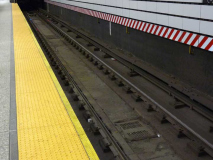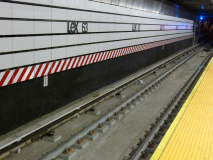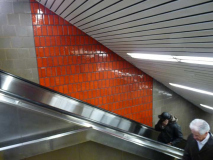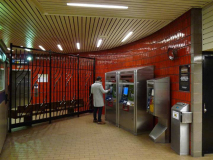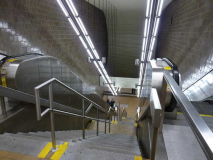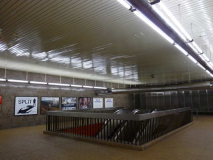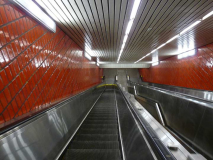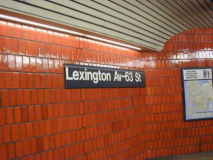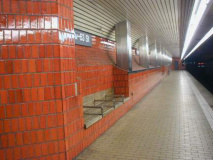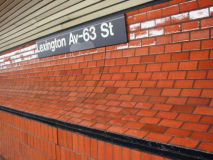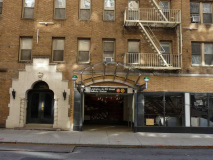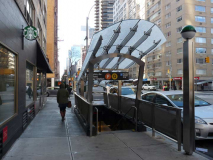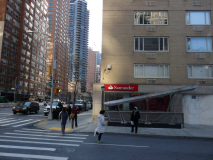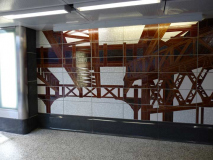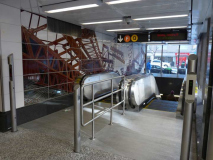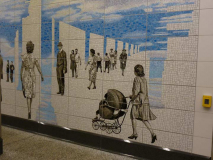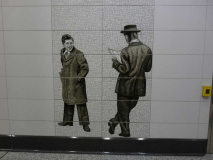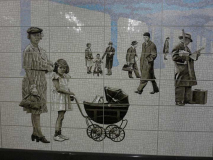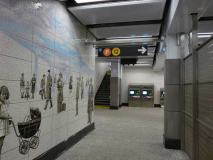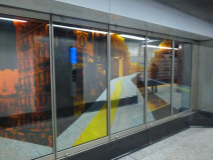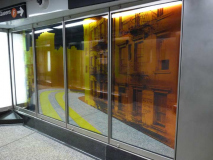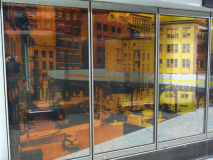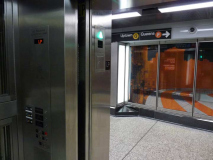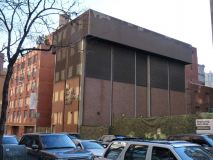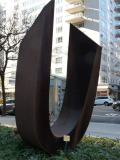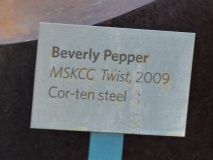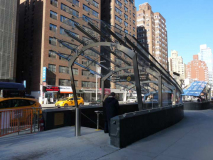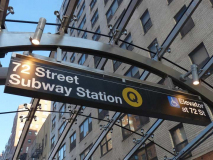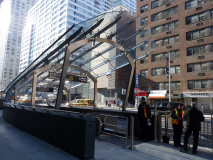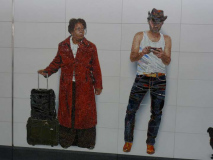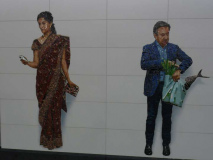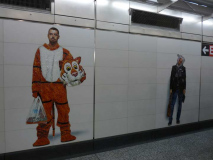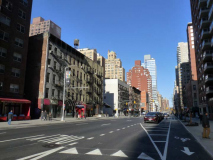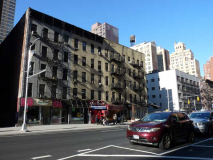Well, the 2nd Avenue Subway, which opened on 1/1/17, was among the most talked-about events in NYC in late 2016 and early 2017. How can it be Forgotten? I’ll find an angle. It occurred to me that I had never walked up 2nd Avenue along the subway route, as the Upper East Side has been largely unplumbed territory for my camera. The new subway, essentially a northern extension of the Broadway and Brighton Lines (the Q train for those unfamiliar with the nomenclature) runs up 2nd Avenue between 63rd and 96th Streets, with a northern extension to 125th Street expected by the late 2020s, by which time I may or may not be alive! Thus, I thought it important to be there on the subway’s opening day — I had never been present on opening day for any previous subway line.
Thus, I decided to explore both 2nd Avenue for interesting things in a Forgotten New York vein, as well as the new stations themselves. If you’re from out of town, this is a rare chance for you to take a look at these spanking new additions to the MTA subway system. I’ll also take a look at the art installations for all three new stations, and the new renovations to the fourth. I’m not an art critic, but I can provide some information on the new images on the walls.
Here’s a short history by National Public Radio of the 2nd Avenue Subway, first proposed in the 1920s. Wars, depressions and recessions, as well as the high costs of construction, have delayed and whittled the project down over the years.
GOOGLE MAPS: SECOND AVENUE SUBWAY ROUTE
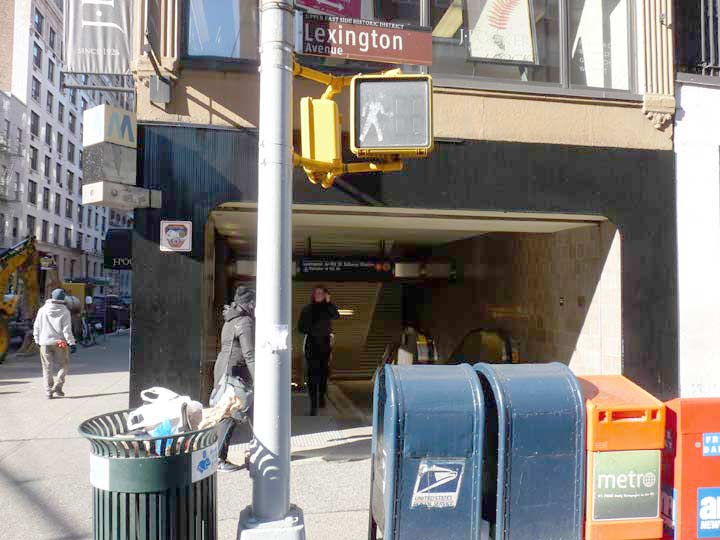
I’ll begin my survey, not at 2nd Avenue, but at Lexington and East 63rd, one of the entrances to the rebuilt Lexington Avenue station that first opened in October 1989, making it an oldster next to the three new Second Avenue stations, but a whippersnapper compared to most other NYC subway stations.
As originally configured, the station consisted of two levels, one track each, serving the F train which turns east from 6th Avenue, with the Manhattan-bound trains using the upper level and Queens-bound the lower. For several years, the station was under new construction while a second trackway was added to each level, one going to Queens and the other the new 2nd Avenue-bound track.
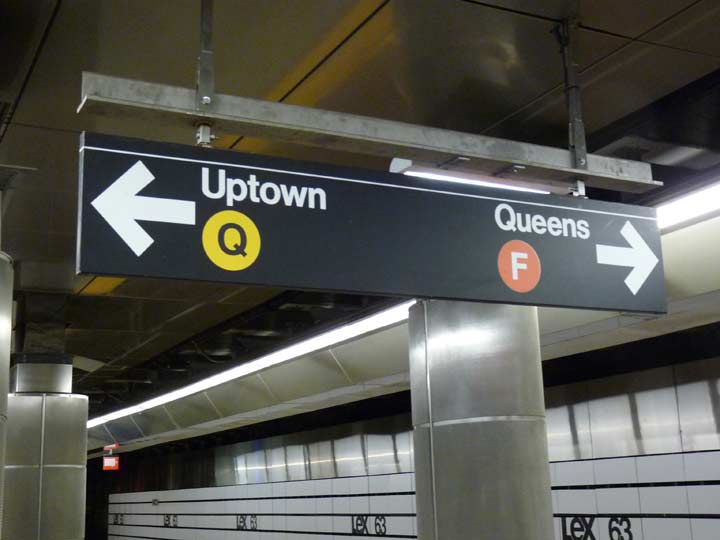
What the new 2nd Avenue line has produced is the only crossplatform transfer between the Q and F in the subway system. The two lines come together further south at West 8th (they are on different levels there) and at the Stillwell Avenue Terminal at Coney Island, where they are on two separate platforms.
Though the addition of the new trackway seems to be seamless, it’s immediately apparent by looking at the trackbed which line is the older one (the F train side).

The platform and side walls of the newly christened Lexington-63rd Street station feature, like the three new SAS (that’ll be my abbreviation here out, folks) white and black horizontally striped sidewalls with the station name in black Helvetica, terrazzo station floors in gray with yellow safety striping, and columns coated with a metallic mesh. However, the SAS stations do have splashes of color other than their artwork that I’ll get into a bit later.

One interesting aspect of the Lex-63 wall signage is that unlike the other SAS stations the letters and numbers were typeset so they appear to be overlapping each other, or were cut out and placed atop the other. An interesting touch.
To me the most distinctive aspect of the Lexington Avenue entranceway is how some of the 1989 decor has been preserved. This station and others built in 1989 including Roosevelt Island and 21st/Queensbridge Houses are among the deepest in the system; I’m not exaggerating when I say the tracks are halfway down to Mongolia. When first opened the Lexington Avenue station had its walls covered with bright burnt orange, similar to the present Bowling Green stations (4, 5) and 49th Street (R, N, W). It takes 4 escalators and a staircase to reach track level, and the escalator landings boasted a glazed gray surface.
This color scheme has been preserved in the access areas. However, the burnt orange that covered the station walls on the original 1989 Lex, seen in this gallery, has been replaced by white.
Bear in mind there’s an even lower level! Below the subway tracks on 63rd Street are a separate set of tracks that will eventually accommodate the Long Island Rail Road when the East Side Access (to Grand Central Terminal) project is finished, reportedly in the mid-2020s. Those tracks have been there since work first got underway on the 63rd Street tunnel in the Swinging 1960s!
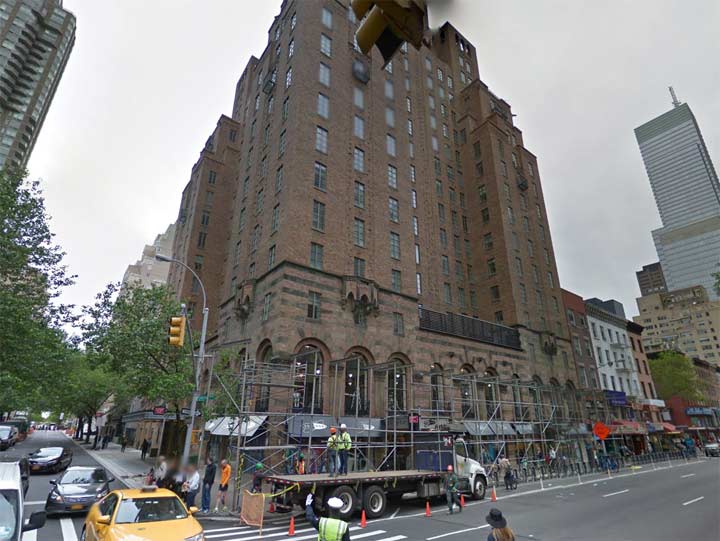
Time to walk over to Lexington for a look at the other entrance to Lex/63rd. The sun wasn’t in a good spot for me to snap the Barbizon Hotel on the SE corner of Lex and 63rd so I’ll depend on Google Street View here. It is a combined Renaissance/Gothic building completed in 1927 as a women’s hotel, named for the art community in northern France that also gave its name to a professional modeling school. The hotel’s strict policy barred men from all but the ground floor until 1981 when the policy was relaxed. The building was remodeled as a luxury condo complex in 2005 and is now known as Barbizon 63.

Unusual method of mounting a fire alarm at Lex and 63rd; you usually don’t see them on stanchions supporting pedestrian control stoplights.

Early 20th or late 19th Century townhouses on East 63rd between Lex and 3rd Avenue. Note the temporary lamppost in right center. In the middle is also the landmarked Spanish Baroque Cyril and Barbara Rutherford Hatch House (1919).
The 3rd Avenue entrance is where the artwork unique to the Lex/63rd station is, but before entering, I’ll point out an unusual entrance to the refurbished station that was created in 200 East 63rd, on the southeast corner of 3rd Avenue. It is another Baroque building with a stepped Flemish-style motif at the entrance. Oddly, I can’t find anything online about how the station was added to the ground floor.
A hallmark of the new SAS is the reinstitution of entrance kiosks. When the original 28 stations of the first line of the Interborough Rapid Transit were built between 1900 and 1904, heavy iron kiosks covering separate entrance and exit steps were built. Over time, as the automobile gained prominence and car and truck traffic came to dominate NYC streets, these large kiosks were found to inhibit sight lines in an era when every corner was not controlled by stoplights. Thus, most were demolished, with the last few hanging on until the late 1960s.
I’ll provide a better look at entrance kiosks at other SAS stations further down, but you can see the template here, with glass or translucent plastic roofs and a somewhat smaller footprint than the old kiosks.
Korean-American artist Jean Shin created the station artwork based on archival photographs of the old 2nd and 3rd Avenue El structures (which were torn down in 1942 and 1955 in Manhattan, respectively) employing ceramic tile, glass mosaic and laminated glass.
Shin also used archival photographs to show typical crowds riding on or waiting for an elevated train to arrive, chatting, pushing carriages, reading newspapers. One thing I’ve noticed about archival photographs is less smiling than in contemporary pictures. I recall reading a story in the Utne Reader ten or 12 years ago noting this tendency and while I couldn’t find it, there’s a more recent piece from 2009 explaining that smiling is still not frequent in public in Russia.
The platforms are so deep that at the 3rd Avenue entrance, designers forewent the multiple escalators and installed banks of elevators instead. Facing the elevators are a group of elevated train scenes, but the MTA cheated a little and showed other els besides the 2nd and 3rd Avenue.
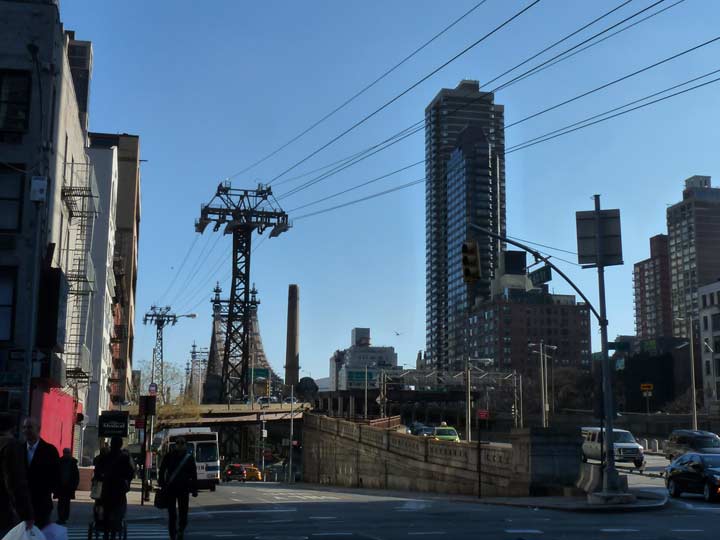
Heading over to 2nd Avenue now (“finally, they said…”). Approaching east from East 60th, we see here the vehicular approach to the Queensboro Bridge (1909) and the stanchions supporting the Roosevelt Island Tram (1976), originally meant to be a temporary measure, but turned out to be the only way to get to the island from Manhattan between 1976 and 1989, with no ferry service. Access was via tokens until the early 2000s. However, access to Roosevelt Island may not have needed a tram had a certain transportation service been maintained…
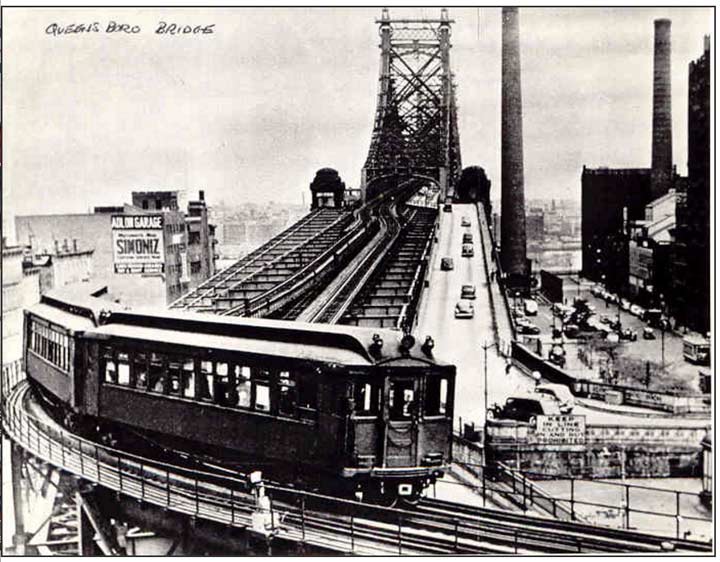
A Manhattan-bound Second Avenue Elevated train navigates the curve onto the avenue from the Q-Boro in what looks like the early 1940s. SAE trains traversed the Q-Boro, terminating at Queensboro Plaza, until 1942 when all SAE service was terminated and the el torn down, as well as one of the double-decked Queensboro Plaza platforms. Had el service been maintained on the bridge, a mid-span stop could have been built for Roosevelt Island; streetcars had a mid-span stop for access to the hospitals on what was then Welfare Island until 1957, with elevators bringing passengers down to the island. photo: nycsubway.org

 Looking north on 2nd Avenue at the el train taking the curve off the bridge. The painted sign for Day & Meyer Storage was visible until just recently when a condo tower was built, obscuring it. photo: nycsubway.org
Looking north on 2nd Avenue at the el train taking the curve off the bridge. The painted sign for Day & Meyer Storage was visible until just recently when a condo tower was built, obscuring it. photo: nycsubway.org
The sign is painted on the side of the warehouse it advertises, on 1166 2nd Avenue. The building still hosts self-storage and boasts Art Deco touches contemporary with its date of construction in 1928.
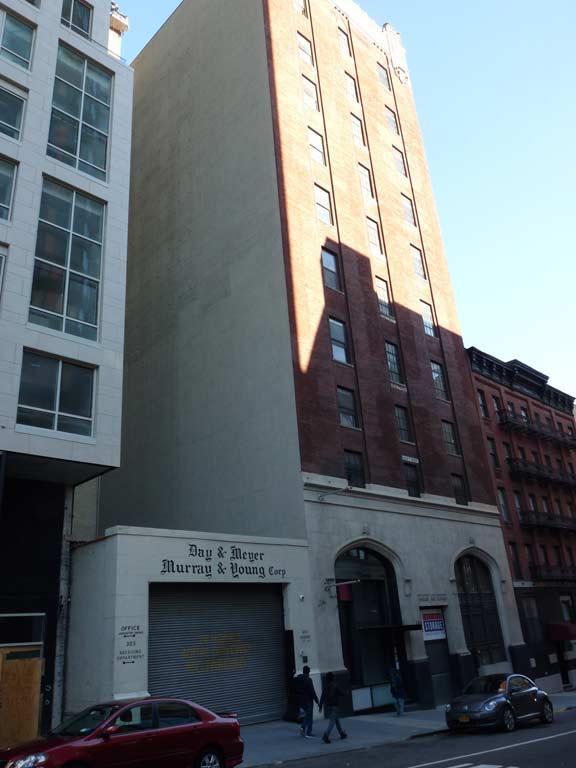
The blackletter style can still be seen above both entrances on 2nd Avenue and also on East 61st Street.
The Second Avenue El and Third Avenue Els were closely related, though the SAE ended service in 1942 and the 3rd Avenue persisted until 1955 in Manhattan and 1973 in the Bronx. Both lines began service in 1880, shared trackage between South Ferry and Chatham Square at Bowery and East Broadway, where the line split in two, the Second Avenue running on Division Street, Allen Street, 1st Avenue, East 23rd, 2nd Avenue all the way uptown to the East 129th Street Yard, where it re-merged with the 3rd Avenue El and crossed the Harlem River; the yard has left no trace and is now the site of the Harlem River Park.
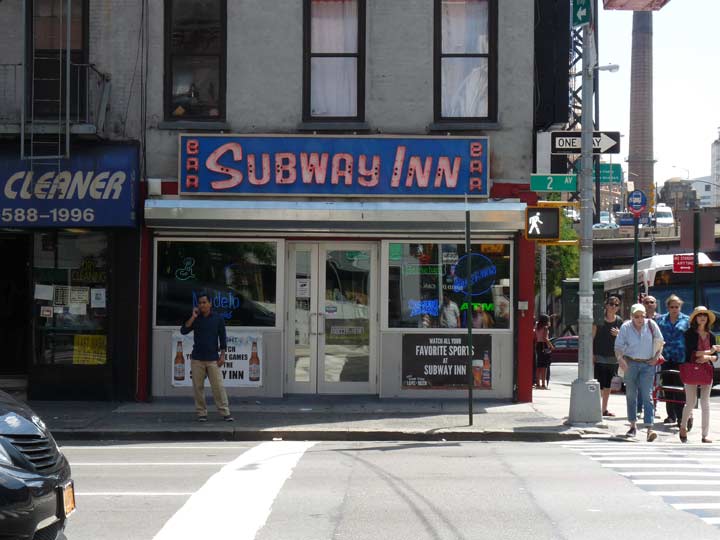
I’ve never been in the Subway Inn in either of its locations, but that’s OK, I’m really here to mention its red neon sign, which survived its transplant. For eight decades the Subway Inn held forth at 143 East 60th Street at 3rd Avenue, right outside a subway entrance leading to the 4, 5, 6 and N, R and W subway lines. The old place was aptly named. However, in 2015, it lost its lease, as its building was sold and a high-rise was due to rise in its place. However, in a fortuitous occurrence, the Salinas family that owns Subway Inn found a prime locale just a block away at the corner of 2nd Avenue and East 60th, in the shadow of the Roosevelt Island tramway.
Read the whole story on FNY here.
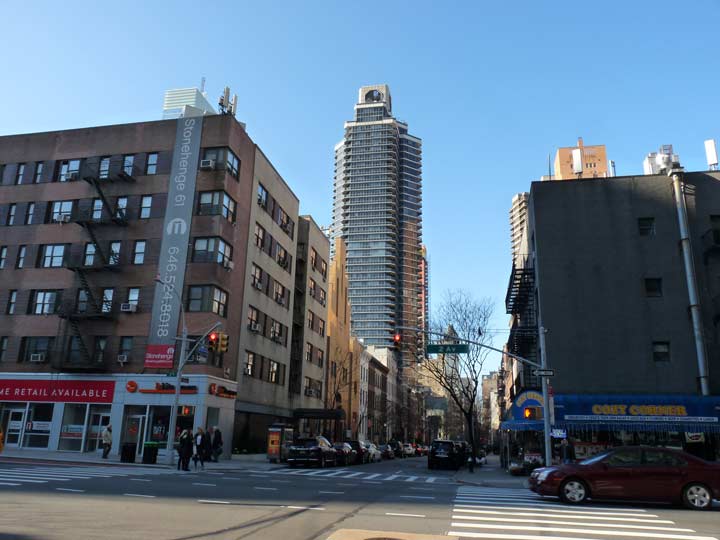
At left, Stonehenge 61 at 2nd and East 61st, named for the Neolithic-era stone arrangement in England, and in the background, the 42-floor Savoy apartment complex at 3rd Avenue, completed in 1986.

Beginning at East 62nd Street, the west side of 2nd Avenue presents an unbroken line of high-rise apartment houses. A bit on the samey side. However, the blocks west of here, between 2nd and 3rd Avenues, along 61st and 62nd, are a different story: that’s the locale of the Treadwell Farm Historic District, the site of some handsome rowhouses built between 1868 and 1876.
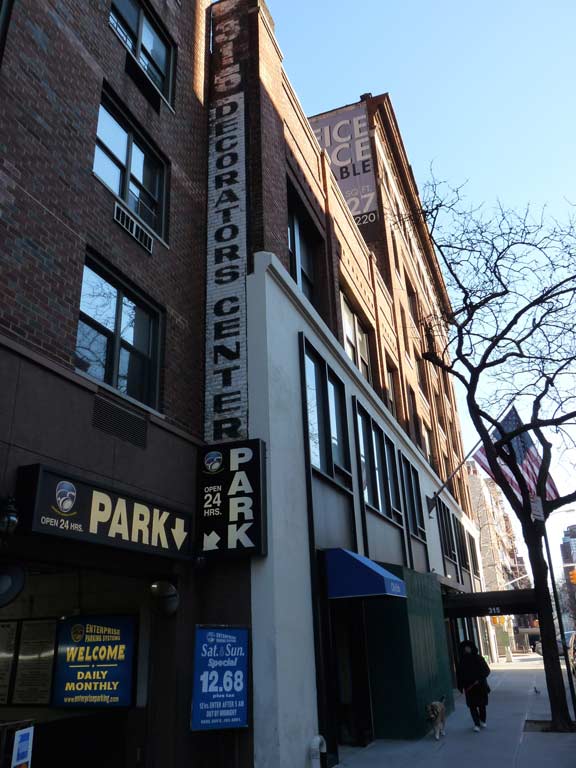
A rare painted ad in these parts, on East 62nd east of 2nd for a “Decorators Center” at #315.
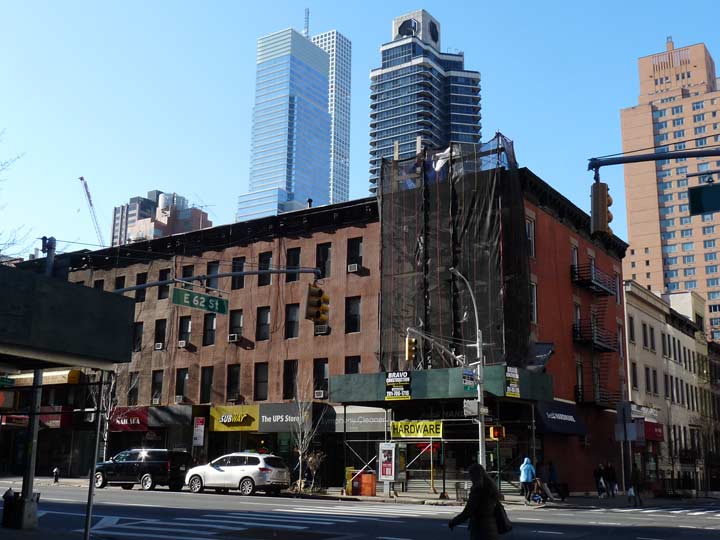
I enjoy photographing contrasts in Manhattan and the other boroughs; here’s a row of attached walkups along 2nd Avenue south of East 62nd, contrasted with the new towers in the background, the Bloomberg Tower (731 Lexington, 2004), 432 Park Avenue partially obscured behind it, and the aforementioned Savoy.
As the sign says, the MTA in early 2017 was working on the tunnel for East Side Access, due to connect the Long Island Rail Road from Sunnyside Yards to Grand Central Terminal. The project is now due to finish in the mid-2020s with likely more delays to come. The original tunnel, currently under modification, runs underneath the subway tunnel on 63rd Street. Here, the 2nd Avenue line turns north.
A large MTA ventilating tower stands on East 63rd east of 2nd Avenue.

The bright white Manhattan House complex fills the entire block between 2nd and 3rd Avenues and East 65th and 66th Streets.
One of the most influential post-war buildings in New York City, Manhattan House marked the beginning of the age of “white-brick monstrosities” in the eyes of some observers and the first big splash of International Style modernity in the city to others.
The mammoth development, which occupies the full block between Third and Second Avenues and 65th and 66th Streets, actually is clad in a light gray-brick, but niceties aside it presented a “clean,” “neat,” almost Spartan appearance in distinct contrast to the historical styles of earlier periods and the Art Deco stylizations of the 1920s and 1930s.
Designed by Skidmore, Owings & Merrill and Mayers & Whittlesley, it was built in 1950 and was, according to Robert A. M. Stern, Thomas Mellins and David Fishman in their superb book, “New York 1960 Architecture and Urbanism Between The Second World War And The Bicentennial” (The Monacelli Press, 1995), “the most literal manisfestation in New York of Le Corbusier’s postwar conception of vertical living, which the master himself was not to realize until 1952 in his Unité d’Habitation at Marseilles.” Carter B. Horsley [City Review]
The allure of modern sculpture escapes me, if only because I figure I could have come up with what looks like a building girder shaped into a letter U. What do I know? Beverly Pepper, 94 years old in 2017, has been exhibited in well-known museums worldwide. Oddly I had come across the name once before — not the sculptor, but an LP by an Arizona psychedelic/garage band called the Marshmallow Overcoat.
At East 69th Street is the southern entrance to the 72nd Street SAS station. The three new SAS stations can be accessed from two streets three blocks apart. I’ll show the 72nd street entrance, the grander of the two, further down the page. The MTA constructed the 69th Street entrance on the east side of the street only, while the entrances at 72nd are on both sides. The kiosks follow the template we saw at 63rd/Lex.
What I did on opening day, 1/1/17, is something I wouldn’t ordinarily do, since it wasted some money. I entered the stations, paid the fare to enter, got my photos and then left the stations, since I wanted to continue my walk up 2nd Avenue. I did take the Q back to midtown from 96th Street. After all, I’ll probably not attend any more subway opening days! Entering from 69th Street…
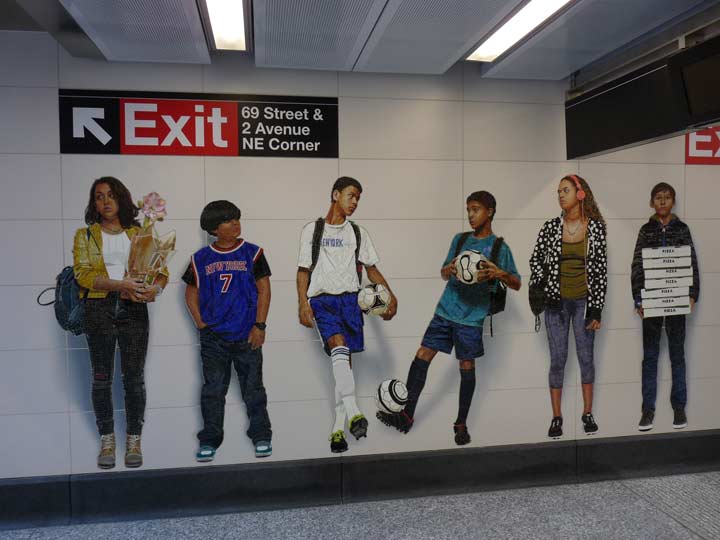
A portrait of some young sports fans in the fare area, part of a larger installation called “Perfect Strangers” by Brazilian-artist Vik Muniz, who photographed more than three dozen subway riders and then re-created them in mosaics. Muniz’ works have appeared in the Museum of Modern Art, Metropolitan Museum of Art, the Guggenheim Museum and the Whitney Museum, a grand slam more or less. He was also featured in the Oscar-winning documentary Waste Land.
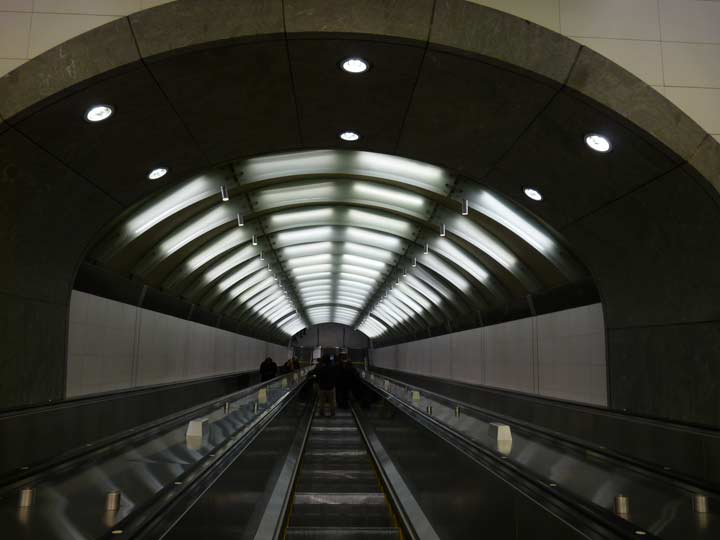
The escalators down to the mezzanine level appear to be from a science fiction movie.
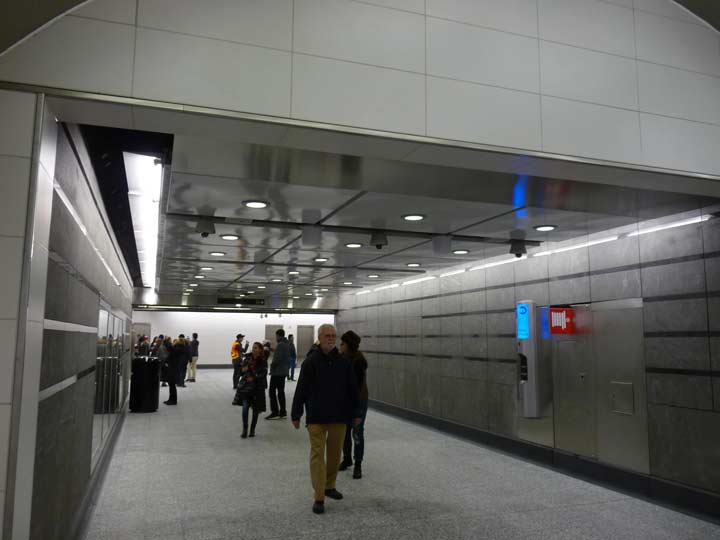
Approaching the above-the-tracks mezzanine. This is the most mundane part of the entrance, since the designers chose dull shades of gray.
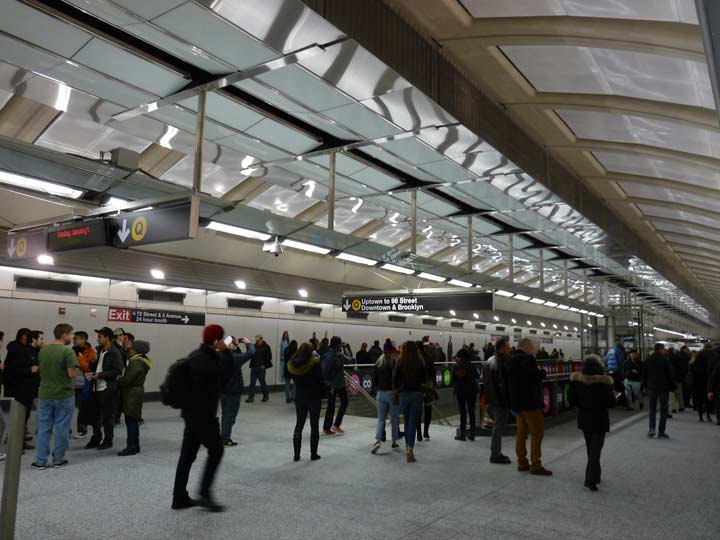
The 72nd, 86th and 96th Street stations all have an above-the-tracks mezzanine. Though it’s far below the surface, there’s the appearance of airiness from the mirror-like ceiling treatment. This is state of the art subway construction, circa 2017. It has to be said that when the Lexington, Roosevelt Island and 21st Street stations opened in 1989, those stations had started construction in the 1960s — so they reflected a 1960s design esthetic!
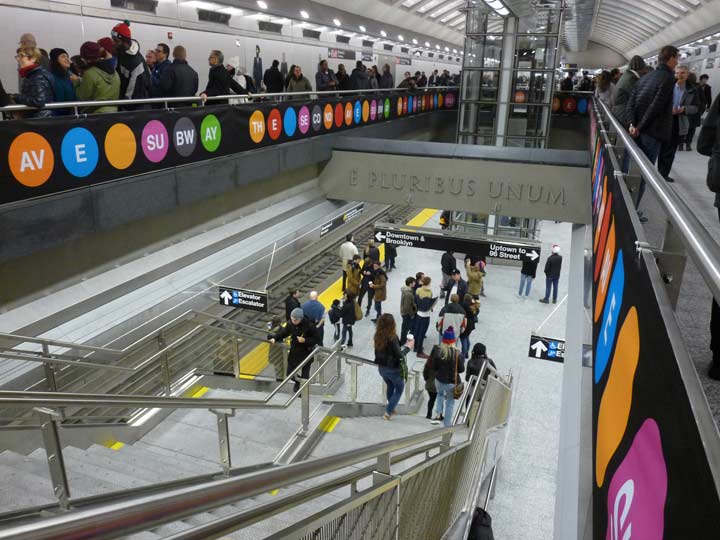
Spaciousness was the hallmark in the station design. There’s a “floor-through” to the tracks below. The station walls are the same horizontally striped white with station number in black Helvetica. The floors ate steps are light grey terrazzo and the railings in gleaming chrome. With all the bright and white surfaces, can these stations be kept clean indefinitely?
The Latin phrases “E Pluribus Unum” (one out of many) and “Excelsior” (ever upward) appear above the staircases in each station, the mottoes of the USA and New York State, respectively. For me, a bit pretentious, but some like it.
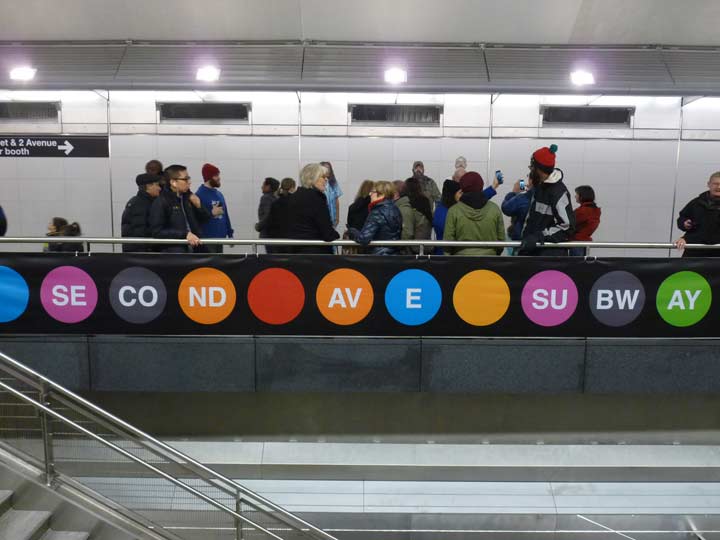
For each new SAS station, the MTA has hung curtains (I suspect they’re temporary) with a motif featuring the color bullets that had been used for train ID up to the new R-143 trains that started rolling about 10 years ago. It’s somewhat curious the MTA would use the bullets like this, since they’ve since been de-emphasized, appearing only in route strips within each traincar. I found the large color bullet on the front of the R-46, R-62 and R-68s a terrific way to know what train was approaching — with the small red bullets on the new cars, you have to wait till the train arrives to know which one it is!
Some more of Vik Muniz’ “Perfect Strangers.” Note the woman holding the cellphone — I suspect it’ll look as dated as a Victrola 5 years from now, when we’re all calling people by pressing buttons on our outfits like Captain Picard and getting data with our Google goggles.
Returning to 2nd Avenue, in the blocks surrounding the stations, it’s never looked better, with new pavement, new stripes, a new bike lane and a new set of City Lights lampposts: the design, by Thomas Phifer and Partners, won a lamppost design competition by the Department of Transportation in 2004, and they’re starting to get rolled out in various spots around town at last.
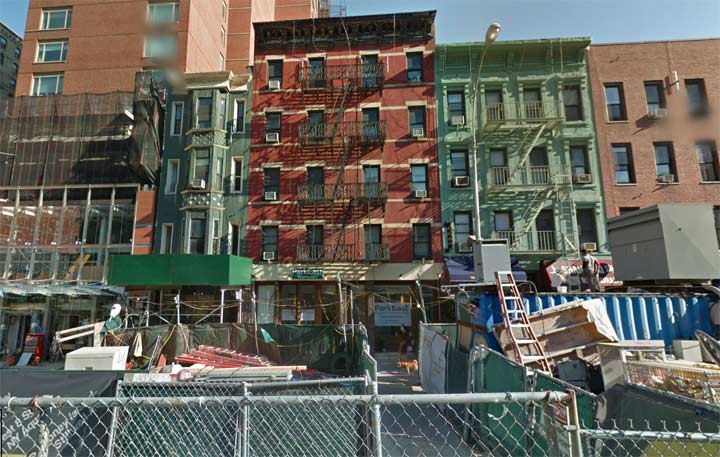
You’ll recall how much of an obstacle course 2nd Avenue was for several years while the new tunnel was being built beneath it. (All that begins again in 2019 when the northern section between 96th and 125th Streets is scheduled to begin construction!) As late as October 2016, 2nd Avenue between 71st and 72nd, and in plenty of other spots, was still a mess.
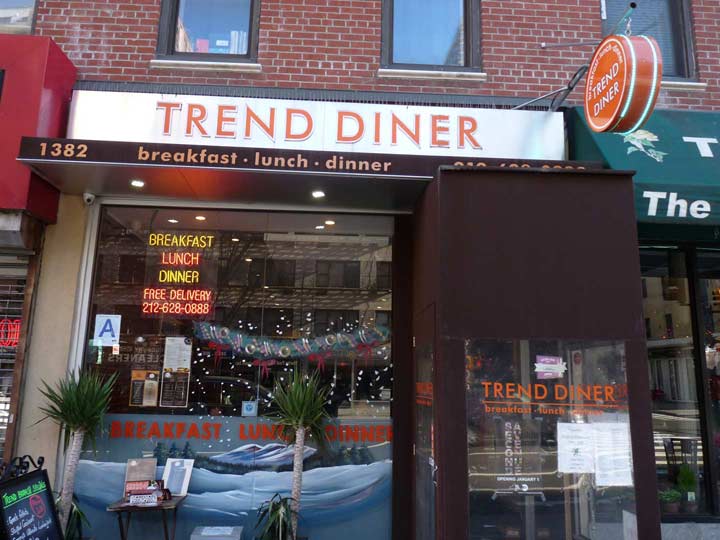
While the MTA was opening new stations, the Trend Diner on 2nd Avenue and East 71st Street was replacing its older neon sign with a new non-neon, but with the same Futura font.

Here’s the glassy, deluxe 72nd Street Station entrance on the NE corner of 2nd and East 72.

…and the slightly less grandiose entrance on the NW corner of 2nd and East 72. This is the only 72nd Street station entrance on the west side of the avenue. Note the bollards set up to stop truck bombs.

Some property at each station had to be condemned so that large ventilation buildings could be constructed. The stations will feature climate control, not air conditioning per se, but the stations will not be furnaces in the summer as many older stations become.
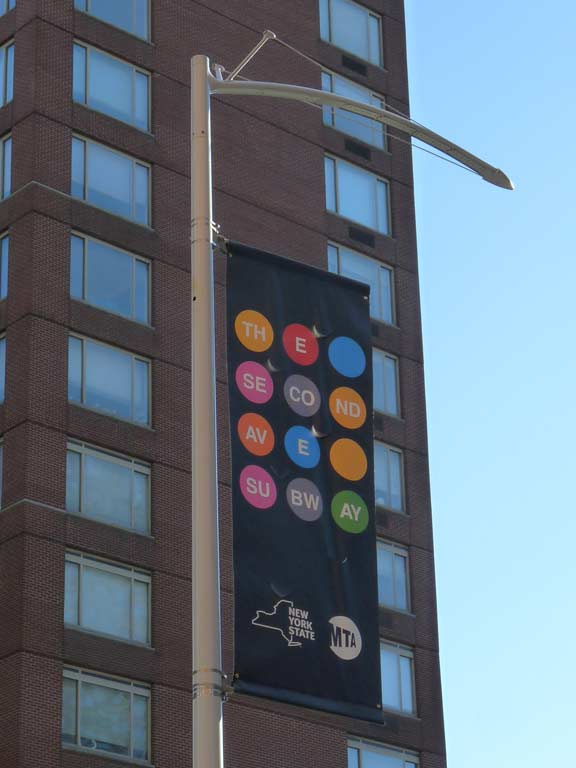
Some of the new City Lights posts have had SAS banners added featuring the trademark color bullets.
Next week: up 2nd Avenue to the 86th and 96th Street stations.
“Comment as you see fit.” kevinjudewalsh@gmail.com
1/22/17


